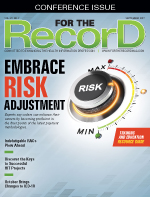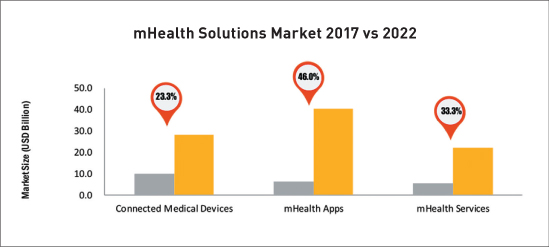September  2017
2017
mHealth Update: mHealth's Role in the Future of Care Delivery
By Nikita Khokher
For The Record
Vol. 29 No. 9 P. 5
Over the past decade, the advent of new communication technologies has spurred the evolution of mHealth. In the coming years, these solutions are expected to witness increasing incorporation across a number of health care fields, from cancer to psychiatry.
mHealth is composed of three main components: connected medical devices, apps, and mobile services. Connected medical devices and apps have emerged as important tools that enable patients suffering from chronic diseases to self-monitor. Services are gaining significant traction in the areas of remote diagnosis, remote monitoring, and personalized patient engagement.
Although they remain widespread, the traditional modes of monitoring and treatment—face-to-face contact with health care providers and the exchange of information through conversation—are increasingly being replaced with online telecommunication modes such as mHealth. These solutions allow medical practitioners to evaluate and diagnose patients, ePrescribe medicines and treatments, and detect fluctuations in medical conditions through remote consultations.
Connected medical devices also help monitor various health parameters at home, eliminating the need for hospital visits, thereby reducing escalating health care costs. By facilitating swift and secure information exchanges, cloud-based remote patient monitoring allows health care providers to better determine whether office or emergency department visits are necessary.
The penetration of smart gadgets, increasing utilization of connected medical devices and mHealth apps in the management of chronic diseases, the advent of advanced connectivity and network technologies, and 3G and 4G networks' ability to provide uninterrupted health care services are expected to drive growth in the mHealth sector. These applications are also expected to support the transition of health care delivery from institution-centric frameworks to patient-centric care.
How to Get Physicians On Board
Currently, patients suffering from chronic diseases are the major users of mHealth apps, followed by health- and fitness-conscious consumers. This is due to the rising incidence and prevalence of chronic diseases, the growing adoption of mHealth apps in home care settings, and the cost advantages apps afford in the treatment of chronic diseases.
However, some physicians have been influenced by negative perceptions of telehealth and mHealth solutions, making them leery of the technology's value. They believe adoption would increase data entry demands, create huge data flows, interrupt typical workflows, and increase competition from other states' telemedicine networks. In addition, a lack of IT knowledge among health care professionals and reimbursement concerns are commonly cited as hindrances to telemedicine adoption.
Although enterprisewide cloud-based solutions allow health care providers, insurers, and patients to save time and costs, some professionals believe the utilization of these apps is a time-consuming task with limited or no clinical benefits. However, this concern can be mitigated by instituting standards for mHealth solutions and reimbursing physicians for integrating health apps in their treatment plans.
Additionally, the adoption of mobile medical apps can potentially be improved by increasing awareness among health care professionals and offering inputs or incentives to physicians for recommending the use of mHealth technologies to their patients. Engaging physicians during app development and clinical pilot testing can also raise awareness. This would help to ensure the app's clinical relevance and thereby promote its utility for achieving clinical benefits.
Over the last two years, there has been a significant increase in the number of health care apps available on the market. This is due to the growing number of mHealth app publishers, the increased importance of multiplatform app publishing, and the expansion of existing mHealth application areas.
However, the demand for these apps has declined in recent years, especially in developed countries, due to the growing number of apps offering similar functionalities. Consumer fatigue is also a major challenge.
Considering these challenges, market players must focus on specific app launches offering innovative features to ensure high consumer acceptance in saturated market segments.

Outlook
The mHealth market is estimated to register high growth over the next five years based on the following expectations:
• a rapidly increasing user base;
• advancements in app service offerings;
• strengthened business models;
• growing use of connected devices; and
• an improved reimbursement scenario for app-based services.
With this potential for growth, various players are entering the market despite barriers such as a lack of regulations, physician reluctance, and a hesitant customer base unsure of how to select the most appropriate app.
Numerous companies are focused on creating reliable mHealth solutions that can ensure interoperability, secure data, and comply with existing regulatory standards. Moreover, the integration of mHealth apps into the health care system will offer significant opportunities for market growth. Currently, market players are working on developing application programming interfaces to connect apps to third-party apps, sensors, and data aggregators.
While connected medical devices will continue to hold the dominant position in this market, so-called "freemium" apps will play a pivotal role in shaping both the revenue and technological growth of mHealth over the next decade. Furthermore, stakeholders within the mHealth ecosystem must address industry barriers.
By implementing reimbursement models that encourage the use of mHealth apps in care delivery, payers are also expected to play a pivotal role in integrating mHealth solutions within health care systems. This will lead mHealth to revolutionize the shape of care delivery and chronic disease management across the globe.
— Nikita Khokher is a senior health care research analyst at MarketsandMarkets.



